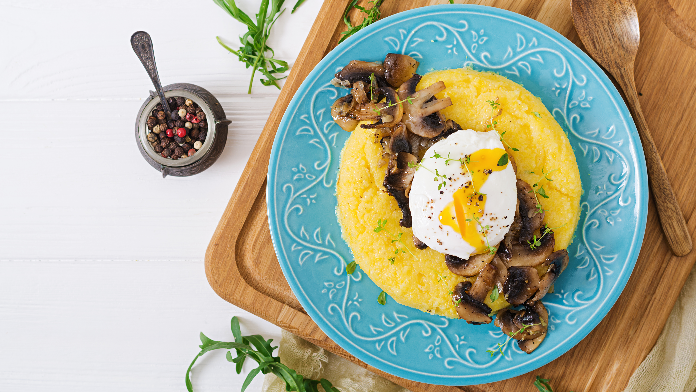Does polenta make you fat? No, if you simply prepare it with water and cornmeal, provides about 100 calories per 100 grams. Corn is one of the most digestible foods of all and also has advantages from a nutritional point of view. It is suitable for celiacs, as it does not form gluten in contact with water, and has little chance of developingacrylamide, a carcinogenic substance that is produced when the flours are subjected to temperatures above 120 ° (in our case, grilling the polenta or gratinating it). Chiara Manzi, president of the Italian Academy of Culinary Nutrition: Cucina Evolution Academy, explains in detail how to combine it and how to cook it.
Polenta must be combined with other foods
The corn limit is one low fiber content, the lack of which in the diet creates damage to the bacterial flora which increases the risk of diseases, from obesity to chronic inflammatory diseases. Foods low in fiber have a very high glycemic index, with the risk of being hungry again shortly after consuming a large plate. Because of this, polenta should be combined with foods rich in fiber, such as mushrooms and vegetables, which simultaneously also increase the vitamin content. One trick, taught in the Italian Academy of Culinary Nutrition, is to cook it including buckwheat flour in the preparation (the polenta taragna) o l’inulina, a white fiber that is extracted from chicory. Without changing the color and consistency of the dish, it significantly reduces the glycemic index.
Some varieties of corn are better
The top is the Marano di Marano Vicentino corn, a protein-rich flour obtained from the crossing of two Venetian varieties, the Pignoletto d’oro and the Nostrano. Similar is the Trentino Nostrano di Soro, excellent for preparing carbonara polenta. Also worth mentioning are Scaiolo dell’Isola from Bergamo, Sponcio from Belluno, Ottofile and Pignolet from Piedmont. Very valuable is also the Biancoperla, traditional in the Polesine, Treviso and Venice areas, with a characteristic white color, perfect for a polenta to accompany fish.
The calories change depending on the grind
It is true, depending on the grind, the calories also change, varying between 80 and 130 per 100 grams. A firm polenta will contain more than a liquid one. Consistency that, from more compact to very soft, is determined by three different types of grinding of the yellow corn that produce as many flours:
- longing, coarse grain;
- medium ground, with finer grain;
- finely ground, very fine-grained (foil).
There are polenta without corn flour
There are polenta without corn flour. The best known is that, cited above, by buckwheat. Cereal from the Valtellinese gastronomic tradition, it is richer in fiber than that of corn and, therefore, better from a nutritional point of view. But, before Christopher Columbus introduced corn to the West from the Americas, in Europe polenta was prepared with wheat, spelled, rye, chickpeas and chestnuts, of which a large trace remains in the various local kitchens of our country.
How to cook polenta?
Better to cook the polenta in a copper cauldron because this material migrates from the cauldron to the food only in the case of cooking acidic foods, which polenta is not. Today there are electric cauldrons complete with a shovel to constantly turn the polenta. However, pots with high sides and convex bottom, made of cast iron or copper, should always be used to spread the heat evenly. The most suitable pots for healthy cooking.
It takes a long time to prepare it
It is necessary during cooking mix the flour slowly with the spatula between fifty minutes and an hour and a half. The coarser the grain, the longer it will take to obtain a compound without lumps. The longer the polenta is cooked, the more digestible and tasty it becomes.
How often to eat it?
You can eat polenta even every week but only if it is cooked according to the rules of culinary nutrition (low in fat and added fiber to the final cold creaming). However, it is better to vary the diet to take all the nutrients necessary for our body in the right quantity.
What are the healthiest toppings?
It can also be healthy with cheese and meat, as long as you follow some precautions. For those who love, for example, to dress polenta with butter and parmesan, a good method is to add these dairy products only at the end of cooking. Taste and shine are guaranteed but are obtained with a reduced amount of these ingredients. In the case of polenta concia, that is, fused with cheese, typical of the mountains of Northern Italy, the advice is to use very tasty cheeses, because in this way a minimum quantity is enough to flavor the dish. From this point of view, for example, it makes Gorgonzola better than fontina cheese and mature cheeses are also not to be underestimated. It is true that they are fatter than fresh ones, but much less is enough to satisfy the taste buds. Polenta con lo is also a classic stew. In this case we must learn to reduce salt and fat in the preparation, because otherwise we will spend the two to four hours following the meal very heavy.
Polenta dipped in milk
It is correct to soak the polenta in milk as long as you use partially skimmed and non-whole milk, whose fats are partially saturated. The polenta should be left to cool, then cut into slices (for those who want, also toasted on a grill) and, finally, put in the cup containing the milk.
